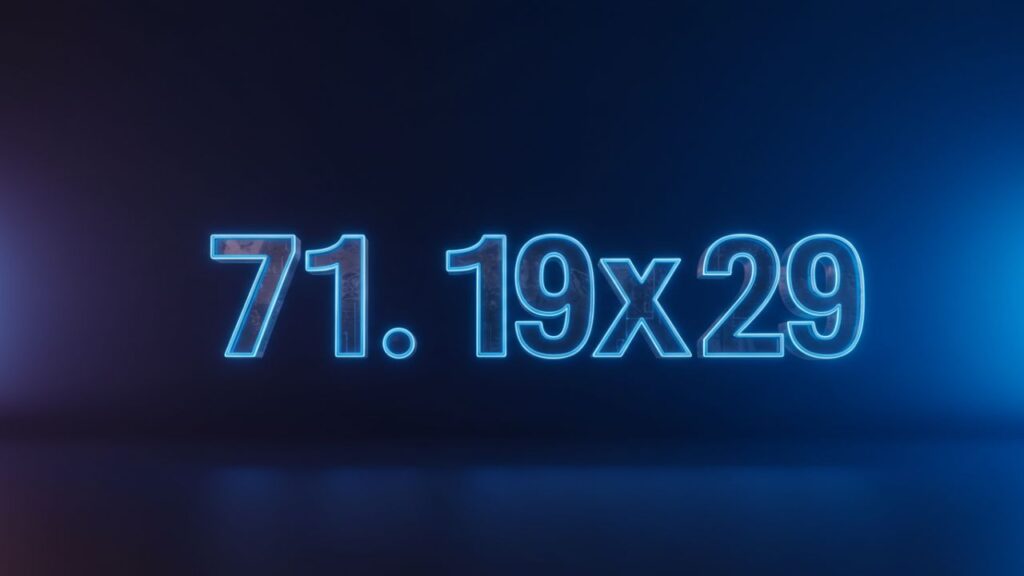Introduction
The term 71.19x.29 may look cryptic at first glance, but it holds surprising depth and versatility in several fields. Whether it’s in immaculate grid layouts, map coordinates, data formatting, or mathematical modeling, 71.19x.29 often signifies a precise ratio or coordinate system. In this article, we’ll delve into what 71.19x.29 means, how it’s used, why it matters, and what best practices are associated with it.
What Exactly Is 71.19x.29?
Defining the Components
-
71.19 may represent a measurement: percentage, degrees, coordinate, or a scale value.
-
x often denotes multiplication, a coordinate separator (as in “x,y”), or a marker of dimension.
-
.29 similarly may represent a fractional component, or a secondary measurement.
In many contexts, 71.19x.29 acts like a coordinate pair: “71.19” along one axis, “.29” along another. Alternatively, it could be a ratio: 71.19 to 0.29, which simplifies to a high differential scale, useful in mapping, grid laying, or precision specifications.
How 71.19x.29 Relates to Immaculate Grid Systems
What Is an Immaculate Grid?
An immaculate grid refers to a layout or structure where grid lines, intervals, and subdivisions are precise, clean, and carefully calculated to ensure symmetry, consistency, and harmony. Designers, mapmakers, architects, and data visualizers often rely on immaculate grid systems to maintain proportionality and aesthetic balance.
Role of 71.19x.29 in Immaculate Grid
When creating an immaculate grid, using coordinates or ratios like 71.19x.29 helps:
-
Set fixed reference points: The first value (71.19) may be one axis’s reference; the second (.29) could fix a minor division.
-
Maintain visual balance: Having non‑round values forces precision, ensuring small discrepancies don’t enlarge into visible misalignments.
-
Facilitate scaling: If you scale a grid, ratios like 71.19x.29 help maintain proportions while resizing.
Applications of 71.19x.29 in Various Fields
Cartography and Mapping
In mapping, coordinates such as 71.19x.29 can correspond to longitude and latitude (for example, 71.19° East or West, 0.29° North or South). Such precise coordinates are essential for:
-
Marking small locations: islands, geological features, remote weather stations.
-
Setting boundary lines when legal or environmental implications are involved.
-
Geographic Information Systems (GIS) where tiny fractions of a degree can correspond to significant ground distances.
Graphic and Web Design
Designers may use a dimension set such as 71.19x.29 in CSS or layout grids:
-
Specifying aspect ratios for images or div elements.
-
Defining margins or gutters in a grid‑based layout where small subdivisions matter (for example, responsive design where mobile vs desktop differences are subtle).
-
Working with high DPI or print graphics where precision is essential.
Data Modeling, Analytics, and Measurements
In data science or measurement:
-
A measurement reading could be “71.19 × 0.29 units,” meaning the product or combined measurement is relevant (for instance, area or scaled value).
-
Statistical normalization: scaling data values by specific constants; using 71.19x.29 as transformation factors.
-
Physics or engineering: small constants × larger values often used in formulas, calibration, or when converting units.
Understanding Precision, Rounding, and Significance of 71.19x.29
Precision vs Readability
When using 71.19x.29, precision matters. But designers and analysts must decide:
-
How many decimal places are needed (e.g. 71.190, .290)?
-
Whether rounding to fewer decimals still preserves integrity.
-
When specific tool limitations (printing, rendering, mapping software) force approximations.
Significance and Error Margins
-
Differences of 0.01 in one of the numbers (e.g. .29 to .30) might matter greatly in GPS or architectural plans.
-
Error propagation: when 71.19x.29 is input to further calculations, small initial errors may magnify.
-
Always check calibration of tools, ensure consistency across all grid or measure references.
Tips for Using 71.19x.29 Correctly in Immaculate Grid Layouts
Maintain Units Consistency
Ensure that both numbers are using the same unit system—if 71.19 is in centimeters, .29 should also be in centimeters or converted appropriately. Mixing units (inches vs cm vs percent) could lead to misaligned grids.
Use Reliable Tools
-
GPS tools with high precision for mapping.
-
Design software (Vector tools, CAD, Illustrator) that supports decimal precision.
-
Data tools or spreadsheet software that don’t round off early.
Documentation and Conversion
-
Document why 71.19x.29 is chosen: what reference point it corresponds to.
-
If scaling up or down, keep conversion formulas so that grid proportions are preserved.
Visual Testing
Lay out the grid visually: print or project, see how the divisions appear. Sometimes what’s mathematically correct doesn’t look right due to human perception (optical illusions, spacing perception). Adjust minorly if necessary but always preserve the underlying ratio.
Potential Challenges and Limitations
Human Error in Entry
Entering 71.19x.29 incorrectly (mistyping, misplacing decimal) can lead to large errors. Double‑checking is vital.
Software Rounding and Limitations
Some tools auto‑round decimal values; small decimals like .29 might become .3 or .28; over multiple repetitive operations, cumulative error can happen.
Visual Artifacts in Design
When grids are too fine (i.e. very small fractional units), visual rendering might suffer—lines may appear blurry, print may misregister, or elements not align perfectly on screens where pixel alignment matters.
Real‑World Examples Featuring 71.19x.29
-
A cartographer mapping a remote island might mark its location at 71.19x.29 degrees (Longitude × Latitude), then use an immaculate grid overlay for precise measurement of ecological zones.
-
A graphic designer sets up a magazine layout where columns are separated by widths scaled in ratio 71.19x.29 inches or millimeters to ensure line spacing and margins are consistent across multiple page sizes.
-
An engineering firm designing a sheet metal component might specify cutouts sized with measurements proportional to 71.19x.29 so that parts fit within tight tolerances.
Conclusion
The notation 71.19x.29 might look arcane, but it is a powerful expression of precision, proportion, and practical utility—especially when used within immaculate grid systems. Whether in mapping, design, engineering, or analytics, this sort of specification helps professionals maintain consistency, accuracy, and visual harmony. To use it well, one must understand units, maintain precision, and choose tools that preserve small fractions. When done right, 71.19x.29 becomes more than just numbers—it becomes a foundation for work that is clean, reliable, and beautifully exact.





